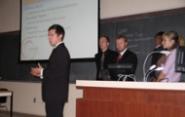From Concept to Market: Developing New Product Designs Worthy of Investment

12/12/2008
There is no engineering course that draws such a diverse array of majors as Professor Henry Bolanos’ Creativity and New Product Development, and there are few instructors with as rich a background and level of excitement as Bolanos. Holding over 110 U.S. patents, Bolanos knows a bit about the topic he so enthusiastically teaches. His career has spanned both national and international corporate assignments in research and development, from microelectronics to toys and child development products. He currently serves as a visiting lecturer at Yale, the University of Virginia, and the University in Auckland in New Zealand, and has worked and lived in Taiwan, Singapore, Japan, and Hong Kong, and continues his business relationships in each of these countries.
The primary class assignment is to develop a new product that can be introduced to the competitive marketplace. “Simplicity is the key,” says Bolanos.
Through lectures on identifying consumer needs, product architecture, marketing plans, patent development, cost analysis and everything else involved in going from concept development to market, students get a hands-on course in what it takes to make money with an innovative design.
At week 7, students have their first opportunity to pitch their idea to their peers, complete with consumer research, product specifications, development costs, sales volume, price point and a prototype. Most of the prototypes are pretty rough, but it’s clear that the students have done their homework and it seems the diversity of majors lends to the success of each group.
When the first group to present experiences problems with the overhead projector, Bolanos tells the class that they should “anticipate having a problem.” The projector malfunction may not cost them any points in his class, but, in the competitive marketplace, it may mean everything. A sampling of this year’s ideas included “no shake” shampoo bottles, an add-on water filter for Nalgene® bottles, a powdered supplement container that would allow storage of premeasured daily supplement quantities, a deodorant touted to provide continuous protection by preventing the body from adapting to active ingredients, and high fashion shoes with replaceable heels. With the feedback from their classmates, the teams spend the remainder of the semester working out the details of development and marketing and preparing for their final presentation, which includes a 30-second sales video. Some may find they have a patentable design. Some might have an idea worthy of investment.
Bolanos says his students have had some good ideas in the past that could have taken off if they had wanted to follow through. Some students have followed through, including a New Zealand team that developed a new ready-mix packaging for small do-it-yourself cement projects. Currently, Bolanos is successfully working with another group from his New Zealand class to revolutionize the plastic bottle-top industry. They’ve developed, patented and are now negotiating the sale of their design with Coca Cola. With billions of bottles sold throughout the world, they’ve likely hit a goldmine. But the idea doesn’t stop there. Bolanos touts product line extensions – in this case, translating the pop-top technology into surgical equipment and beyond.
It’s no surprise that this class is popular across campus – art students and engineers, alike, enjoy the creativity it requires. Team building provides the opportunity for students to learn to work with others of varying backgrounds; peer reviews help students learn to effectively receive criticism; and presenting provides a valuable opportunity for improving speaking skills and ability to convey confidence. Regardless of what the future holds for these students, the Bolanos class gives them a leg up in the competitive job market. If they can reach the level of excitement and determination displayed by some of the New Zealand students, they just might be able to turn a nice little profit from their class project.

